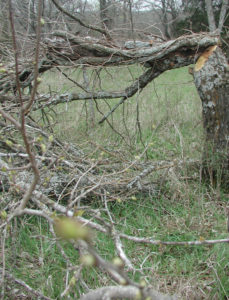Welcome to Stonehaven Bison Ranch….where the buffalo roam.
Creativity isn’t just for artists
I used to think that creativity was solely the purview of artists and novelists. As I’ve grown older, I have found that is not the case. Examples of creativity surround us. Everything we see and use every day required someone at some point to have come up with a solution to a perceived problem.
That’s really what creativity is.
You might not think it, but farming/ranching requires a lot of creative thinking. For example, the bison are crowding the gate and they don’t particularly like the tractor being in the field with them even though you’re trying to bring them hay. What’s to be done?
- Make a trip back to the barn and load up a bag of range cubes, pouring some into a bucket.
- Enter the field through a different gate and begin rattling the bucket and sack of range cubes.
- Bison love range cube, so they come running when they hear the combination of the Ranger engine and the bucket rattling with cubes.
- Quickly drop cubes in small piles spread in a long line.
- While the bison are busy eating the cubes, place the bales of hay in the pasture.
The above scenario doesn’t require a lot of creative thought. The answer to most bison dilemmas at our ranch is range cube. We use it to rotate the bison into new pastures, entice them back into a pasture when they get out and give it to them so that they become accustomed to our presence in their domain.
Other situations, however, require more careful study and thought.
 We were trimming trees along our property line this past weekend in preparation for building a new fence. Kevin cut down an old, dead tree whose large branches I needed to pull off the existing fence into the field, so that he could pile them up with the tractor. Trouble is, the branches landed on top and behind another part of the stump, and there was another large branch in the way. My plan was to fasten a log chain around each branch and use the Ranger to drag it away from the fence. But I needed a way to do that without putting too much strain on the Ranger or damaging the existing fence. Although the fence is old, I didn’t want to break it because the pieces can get caught in the mower.
We were trimming trees along our property line this past weekend in preparation for building a new fence. Kevin cut down an old, dead tree whose large branches I needed to pull off the existing fence into the field, so that he could pile them up with the tractor. Trouble is, the branches landed on top and behind another part of the stump, and there was another large branch in the way. My plan was to fasten a log chain around each branch and use the Ranger to drag it away from the fence. But I needed a way to do that without putting too much strain on the Ranger or damaging the existing fence. Although the fence is old, I didn’t want to break it because the pieces can get caught in the mower.
I took a closer look at the situation, and a simple solution occurred to me:
- Drag the branch in front away first.
- Instead of trying to pull the remaining branch forward against the piece of the stump that was still sticking up, push it off the back of the stump.
- Pull the branch forward and off the fence.
The plan worked. I pulled both branches away from the fence, with minimal stress to the Ranger or the fence.
All problems have solutions; some just take longer than others to figure out.
